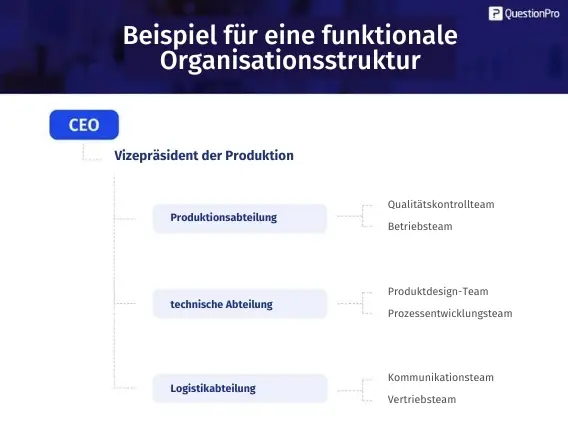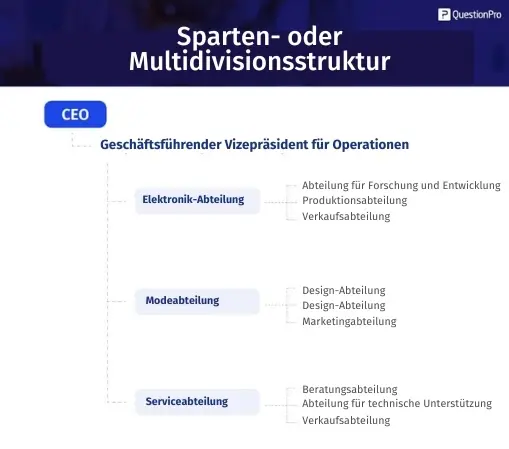Employee Experience
A good organization structure is one of the most important factors so that your employees know their role in the company and can use their full potential to achieve the set goals.
In this article we will show you what an organizational structure is, what types there are and what advantages the correct implementation has in your company.
CONTENT
- 1 What is an Organisational Structure?
- 2 Elements of an organizational structure
- 3 Advantages of an organizational structure
- 4 The importance of organizational structure
- 5 Difference between Organisational Structure and Organisational Design
- 6 5 Types of Organisational Structures
- 7 Choosing the right organizational structure
- 8 What role does the organizational chart play as part of the organizational structure?
- 9 Organisational structure in customer service
- 10 Conclusion
- 11 1:1 Live Online Presentation: QUESTIONPRO EMPLOYEE EXPERIENCE SOFTWARE
- 12 Try software for market research and experience management now for 10 days free of charge!
What is an Organisational Structure?
Organisational structure is the system by which the various components of an organization are ordered and controlled to achieve its goals. This system can include rules, roles and responsibilities.
By aligning and linking the parts of an organization, the organizational structure enables groups within their individual functions to work together and determines the flow of information between organizational levels so that the company can achieve its maximum performance.
The organizational structure chosen influences the success of an organization in implementing its strategy and goals.
Elements of an organizational structure
The elements form the basis of the organizational structure and are essential for successful organizational development. A well-thought-out structure can improve communication, decision-making, and overall efficiency of an organization.
You should consider the following elements of the organizational structure:
- Departments and functional units: Departments represent specific areas within the organization, each with its own area of responsibility. These include sales, marketing, human resources, finance and production, among others.
- Organisation hierarchy: The hierarchy defines the structure of authority and responsibilities in the organization. This includes levels such as top management, middle management and operational level employees.
- Governing bodies: These are the groups or individuals responsible for making strategic decisions and overseeing the overall functioning of the organization. This includes the board and upper management.
- Chain of command: The chain of command is the line of authority that runs from top management through the organization. It determines who reports to whom and how decisions are made.
- Roles and responsibilities: Each task has specific roles and responsibilities that must be fulfilled. Defining these roles is essential to the clarity and efficiency of the organization.
- Internal communication: The structure determines how communication takes place within the organization. It can be top-down, bottom-up, or both ways, depending on organizational culture and needs.
- Rules and Procedures: This is where the rules and procedures that govern behavior and processes within the organization are established. This includes personnel policy, quality policy and much more.
- Organisational culture: The structure influences the culture of the organization. It defines the values, beliefs and norms shared by employees.
- Organisational strategy: The structure must be aligned with the organization's strategy. It must support the company's goals and mission.
- Flexibility: In a constantly changing business environment, the structure must be flexible enough to adapt to new opportunities and challenges.
- Scalability: It must enable the organization to grow without losing efficiency and effectiveness.
- Continuous evaluation and improvement: The structure must be constantly reviewed and improved to ensure its effectiveness and efficiency.
Advantages of an organizational structure
Below are 5 benefits of clearly defining your company's organizational structure and communicating it to all team members:
1. More efficient decision making
Organisational structures can be designed to promote the flow of information from frontline employees to decision makers in companies.
The flow of information that results from an organizational structure can be used to promote faster and more efficient decision making.
If different work teams can communicate better with each other, this also has a positive effect Organisational communication of the company. This will lead to faster and more efficient decision making.
2. Operate multiple business locations
A defined structure helps entrepreneurs create an organizational management chain to ensure that all company locations operate according to the company's standard operating procedures.
An organizational structure helps ensure that all company locations operate in a similar manner and follow the same procedures, especially for companies that work remotely or from anywhere.
3. improving operational efficiency
Organisational structures help delineate the tasks of employees and the people responsible for monitoring their proper execution.
Dividing the company into multiple teams or branches ensures that all tasks and responsibilities specific to those departments can be more easily accomplished. When an employee knows what they have to work on, they can act quickly and effectively.
Organisational structures can also be created with some flexibility to add new departments or employees so that no single manager in the company is overloaded and to avoid organizational silos.
4. Increased employee performance
When an employee is clearly assigned specific tasks and responsibilities, he or she can perform well in his or her job.
An organizational structure provides employees with the guidance they need to do their best work every day, and this improved performance can also lead to higher employee morale and satisfaction.
5. Avoiding duplication of effort
When employees are divided into teams based on their skills and knowledge, the risk of overlapping tasks is avoided.
For example, when a project is assigned to one team, the other teams know that they are not responsible for it because they also have their own set tasks.
The importance of organizational structure
Establishing an organizational structure is an essential step in the design of any business.
The structure not only determines the hierarchy of a company, but also allows the salary structure of employees to be designed.
By defining the organizational structure, the company can determine the grades and salary levels of each position and divide the employees and functions into different departments so that the various activities can easily be carried out at the same time.
When designing an organizational structure, the company must identify the results that the new structure or process is intended to produce, including:
The essential jobs, the requirements for existing functions, new functions or necessary changes, key parameters, responsibilities, critical information flows and decision-making authority by organizational level.
Difference between Organisational Structure and Organisational Design
Organisational design is the process of strategically planning and designing an organization in terms of its goals and resources, while organizational structure refers to how tasks and people within that organization are organized and divided to achieve those goals.
Design precedes structure because it involves strategic decisions that are then implemented through the organizational structure.
| Organisational design | organization structure |
| The process of planning and designing the organization | The way tasks and employees are organized and divided |
| Involves strategic decision making and planning goals and strategies | Defines hierarchy, departments and supervisory relationships |
| Determines the distribution of responsibilities, authorities and resources | Determines the structure and connections between the parts of the organization |
| Focuses on efficiency and achieving organizational goals | Establishes formal authority and communication relationships |
5 Types of Organisational Structures
There are different types of organizational structures, as follows:
1. Functional organizational structure
The functional structure divides the work and employees according to specialization. It is a hierarchical, usually vertically integrated structure that divides a company according to the specialization of its employees.
In functional structures, employees report directly to the heads of their functional areas, who in turn report to an organizational leader. The higher-level management must coordinate the specialist departments centrally.
In this functional organizational structure the following can be observed:
- The CEO (Chief Executive Officer) is at the top of the hierarchy and is responsible for the entire organization.
- The vice president of production is responsible for overseeing production processes and has several departments under him.
- The production department is responsible for production operations, with an operations team responsible for production and a quality control team responsible for ensuring quality standards.
- The Engineering department is responsible for product design and process development, with a separate team dedicated to each of these areas.
- The logistics department is responsible for managing the purchasing and distribution of manufactured products and has specialized teams for each of these functions.
2. Divisional or multi-divisional structure
A divisional structure typically divides workers and employees by production, although a divisional structure can also be divided by other variables such as market or region.
A company using this method structures its management team based on the products, projects, or subsidiaries it manages. This type of structure is useful when the product base expands in quantity or complexity.
In this divisional or multi-divisional organizational structure, the following can be observed:
- The CEO (Chief Executive Officer) is at the top of the hierarchy and has authority over the entire organization.
- The Executive Vice President of Operations is responsible for overseeing the overall operations of the company and has several departments under him.
- Each department focuses on a specific business area, e.g. E.g. electronics, fashion and services.
- Each department has its own functional departments, such as research and development, production, sales, design, manufacturing, marketing, consulting and technical support.
- Some departments, such as B. the sales department, may exist in several departments to ensure specific management of the business area.
3. Matrix structure
In a matrix structure, the functional and divisional structure are combined to create a dual leadership situation.
With this structure, employees are divided into different areas or departments. In a matrix structure, an employee reports to two managers who are jointly responsible for the employee's performance.
Typically, a manager works in an administrative role, e.g. For example, one may work in finance, human resources, information technology, sales, or marketing, while the other works in a business unit related to a product, service, customer, or geographic area.
4. Flat or horizontal organizational structure
The flat organizational structure makes the hierarchy and chain of command more horizontal and gives employees a lot of autonomy.
Companies that use this type of structure have a high speed of implementation because they eliminate the typical internal and external barriers of organizational boxes and all units are connected in an efficient and flexible way.
Teams replace departments, and the organization and suppliers work as closely together as parts of the same company.
Everyone, including management, managers and employees, is involved in the decision-making process. The use of performance reviews, particularly with 360-degree feedback, is also common.
5. Modular organizational structure
Modular structures differ from flat organizations in that the components of a product are outsourced.
Modular structures can keep a core part of the product in-house and outsource non-core parts of the product.
Nets are added or removed as needed. For a modular structure to be an option, the product must be able to be divided into parts.
Suppliers on the one hand and customers on the other become part of the organization; the organization shares information and innovations with everyone.
Adapting products and services to customers is the result of flexibility, creativity, teamwork and responsiveness. Business decisions are made at the company, department, project and individual team member levels.
Choosing the right organizational structure
Choosing the right organizational structure for a company can be a complex process and depends on a number of factors. Below are some key steps that can help you make this decision:
- Analyze the company's goals and strategies: Get an idea of the company's goals and the strategies that are already being implemented or are planned to be implemented. This will give you a clear picture of the specific needs and requirements of the organizational structure.
- Assessment of the external and internal environment: Examine the business environment in which you operate, including competition, technological changes, economic and legal factors. Also consider the company's internal culture and values, as well as its size, geographic scope, and industry.
- Defines tasks and responsibilities: Establishes the key tasks to be performed within the organization and associated responsibilities. Group related tasks together and determine which functions or departments are responsible for each task.
- Consider which structural options come into consideration: Analyze the characteristics of each structure and assess which one best suits your company's needs. Consider aspects such as decision-making, communication, coordination and operational efficiency.
- Assessment of flexibility and adaptability: Ensure that the organizational structure chosen is flexible and can adapt to changes in the business environment. Responsiveness and agility are crucial in a dynamic business environment.
- Finding the right balance: Find the right balance between specialization and coordination. Too much specialization can lead to fragmentation and miscommunication, while too much coordination can lead to inefficiency. Look for a structure that allows for effective collaboration between different parts of the organization.
- Test and adjust: Introduce the chosen organizational structure and evaluate its effectiveness as the business develops. Make adjustments and changes as necessary to increase efficiency and achieve goals.
Remember that choosing the right organizational structure is not final and may need to be reviewed and adjusted as the company grows and changes. Be open to adjustments and learn from experiences to continually improve your company's organizational structure.
What role does the organizational chart play as part of the organizational structure?
The organizational chart is a graphical representation of the organizational structure of a company or institution. It plays a fundamental role in managing and communicating the organizational structure and performs several key functions:
- Visualization of the structure: The organizational chart provides a visual representation of the hierarchy and arrangement of departments, units, and positions within the organization. This allows employees to easily understand the structure and chain of command.
- Clarity about roles and responsibilities: The organizational chart clearly defines the tasks and responsibilities of individual positions within the organization. This helps avoid confusion and feature overlap.
- Internal communication: The organizational chart facilitates internal communication because it shows who reports to whom and how the different departments and areas relate to each other. This is particularly useful for decision making and problem solving.
- Identification of key positions: Allows you to quickly identify key locations, such as: B. Managers and supervisors, as well as areas or departments that are responsible for certain functions.
- Organisational planning and design: Assists in planning and designing the organizational structure. It allows company management to evaluate the effectiveness of the existing structure and make adjustments if necessary.
- Orientation for new employees: The organizational chart is a valuable tool for orienting new employees, helping them understand the structure of the organization and their place within it.
- Workload assessment: The organizational chart can be used to evaluate the distribution of workload across different departments and positions, which can be useful for resource management.
- Facilitating professional development: Employees can use the organizational chart to understand professional development paths within the organization and set career goals.
- Decision support: Executives can use the organizational chart to identify key people who should be involved in strategic and operational decisions.
- Reference book: It serves as a quick reference to access information about the organizational structure at any time.
Organisational structure in customer service
An organizational structure in customer service allows professionals to provide the best possible customer service, achieve company goals and satisfy customers.
This structure consists of the hierarchy and roles that a company establishes within its customer service department.
The customer service organizational structure helps professionals understand the expectations of their roles and know which managers and team leaders to approach with their concerns.
By helping to better define a department's hierarchy and assigning specific roles to professionals, customer service organizational structures also help create stronger, more functional teams.
Conclusion
As you can see, a clearly defined organizational structure in your company is a key factor not only for internal improvement, but also for customer satisfaction.
Tools like QuestionPro CX allow you to manage the customer experience by connecting all employees involved in customer service to respond effectively and in real time to all comments, complaints and suggestions. In the same way, platforms like QuestionPro Workforce managing the employee experience and gathering feedback from across your organization.
If you want to know how they work, request a free demo!
1:1 live online presentation:
QUESTIONPRO EMPLOYEE EXPERIENCE SOFTWARE
Arrange an individual appointment and discover our market research software.
Try software for market research and experience management now for 10 days free of charge!
Do you have any questions about the content of this blog? Simply contact us via contact form. We look forward to a dialogue with you! You too can test QuestionPro for 10 days free of charge and without risk in depth!
Test the agile market research and experience management platform for qualitative and quantitative data collection and data analysis from QuestionPro for 10 days free of charge
FURTHER KEYWORDS
SHARE THIS ARTICLE
KEYWORDS OF THIS BLOG POST
organization structure | Organisation | Structure
FURTHER INFORMATION
- Work performance: what it is, how to measure it and how to increase it
- Evaluation of 360 degree feedback: Make optimal use of results
- Performance appraisal process: what it is and what steps to follow
- Evaluation of 360 degree feedback: Make optimal use of results
- Reputation management: tips, software, app
- 270 degrees feedback: what is it, features and examples?
- All information about the experience management platform QuestionPro
- Conducting employee surveys: A specialist article from QuestionPro





